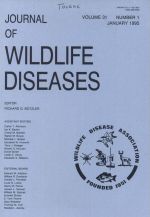We immobilized 10 ocelots (Felis pardalis), and 21 bobcats (F. rufus) in south Texas (USA) during March to November 1991 with a mixture of ketamine hydrochloride (KH) and xylazine hydrochloride (XH); two ocelots were immobilized twice. Species were immobilized with (mean ± SE) 14.7 ± 1.6 mg KH/kg body mass for ocelots, 13.3 ± 1.8 mg KH/kg for bobcats, and 1.1 ± 0.1 mg XH/kg and 1.2 ± 0.1 mg XH/kg for ocelots and bobcats, respectively. Immobilization times in bobcats were longer (P = 0.08) than in ocelots. Adult female ocelots (18.5 ± 2.6 mg/kg) needed larger (P < 0.05) doses of KH than adult males (12.0 ± 1.7 mg/kg). Bobcats were immobilized during summer with lower initial (8.6 ± 0.9 mg/kg, P < 0.001) and total (10.1 ±1.3 mg/kg, P = 0.02) doses of KH than bobcats immobilized in winter (14.5 ± 1.0 mg/kg, and 18.5 ± 3.8 mg/kg, respectively); summer immobilization times (44.3 ± 3.8 min) were also shorter (P = 0.03) than during winter (59.1 ± 5.2 min). Bobcats immobilized during summer had lower (P < 0.01) initial rectal temperatures (39.4 ± 0.2 C) than bobcats trapped in winter (41.1 ± 0.4 C). Overall, we observed no effects of KH-XH dose on body temperature.
How to translate text using browser tools
1 January 1995
IMMOBILIZATION OF OCELOTS AND BOBCATS WITH KETAMINE HYDROCHLORIDE AND XYLAZINE HYDROCHLORIDE
Juan F. Beltrán,
Michael E. Tewes

Journal of Wildlife Diseases
Vol. 31 • No. 1
January 1995
Vol. 31 • No. 1
January 1995
bobcat
Felis pardalis
Felis rufus
immobilization
ketamine
ocelot
xylazine




